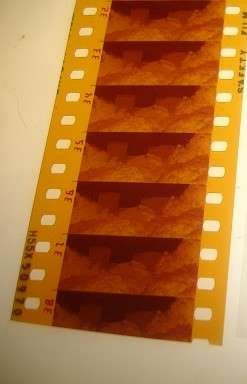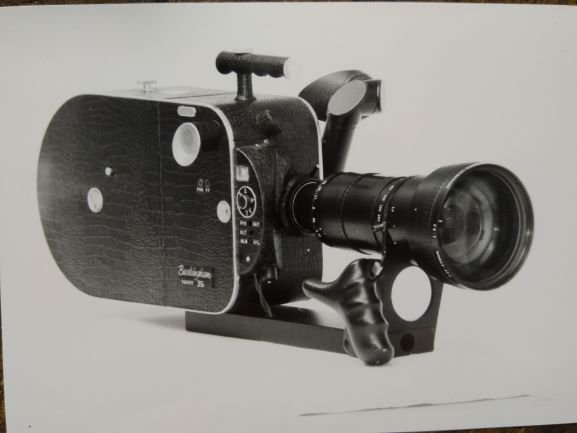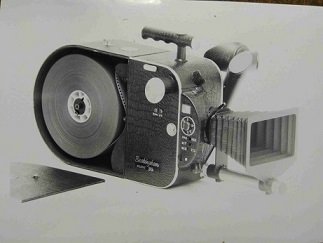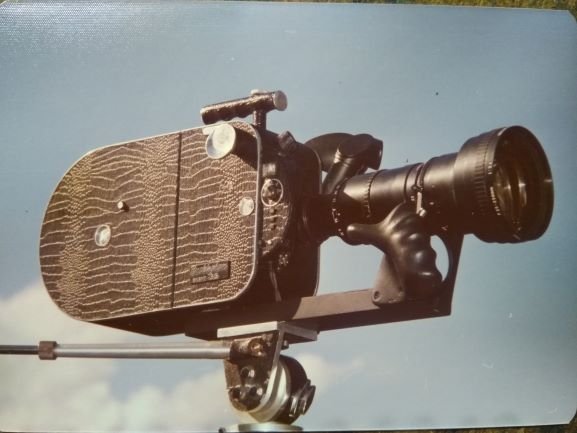
Doug Palmer
Basic Member-
Posts
633 -
Joined
-
Last visited
Everything posted by Doug Palmer
-
Aperture used for shooting miniatures
Doug Palmer replied to Orla Langton's topic in Visual Effects Cinematography
Another idea maybe, if I'm understanding you correctly ?. Is it possible to make the miniature set just with cut-outs... photos etc? They might appear similar to the cut-out effect one sees through a telescope. -
Aperture used for shooting miniatures
Doug Palmer replied to Orla Langton's topic in Visual Effects Cinematography
I understand now thanks, I hadn't read your question properly. I think also like Phil above that it would be maybe better to keep the focal lengths fairly alike, although a very long lens on the miniatures might look wierd. And maybe draw too much attention to them being miniatures. Increase depth of field perhaps by doing single-frame long exposures ? -
Very good points, Martin, in favour of anamorphic.... avoiding any mods to the camera itself. However, maybe one should remember that add-on attachments like the Kowa can sometimes be a bit tricky to focus especially for closeups. You can of course add a diopter lens on to the front, and this corrects for both lenses, if introducing some softness. A S16 or U16 mod avoids this and you can use macro lenses and so on. Ultra-16 can go out further than 1.85:1 ratio, over 2:1, if you can find a film stock that doesn't have intrusive edge markings. eg Wittnerchrome worked perfectly. Attempts to use the wasted emulsion between the perfs of 16mm film have happened for many years. 1954 is the first example I could find: https://filmisfine.com/blog/can-16mm-become-wider/ Since then Variscope and Varispect are two non-standard ways of tackling the problem. I'm not sure though if scanners will cover the wider area.
-
Nice ! I think 2-perf is in many ways a perfect system nowadays. You have economy plus quality, far better than in the past. When I saw the movie Titanic (itself getting old now) on the big screen, I was totally fooled by the 2-perf underwater footage. Also it must have been shot at a wide aperture. Coming back to the Buckingham 2-perf camera, I'm told that there was no problem at all with hairs in the gate. This is the usual criticism of 2-perf, with no room for cropping.
-
Aperture used for shooting miniatures
Doug Palmer replied to Orla Langton's topic in Visual Effects Cinematography
Not sure what you mean ? Can you give more details about the shot ? Is it meant to be a large telescope or normal size etc -
I've got one I use on my Bolex SB. I can't see there'd be any difference with the EBM with its 1:1 shaft. It's a shame the technician couldn't repair it, maybe electronics is hard to fix ? Don't know. It has very useful 4 and 8 second exposures. Ideal for doing go-motion type effects avoiding 'staccato' stop-frame if you need to, and for more light too.
-
Steve doesn't remember too well the 35mm frame numbering, but I understand that the 16mm numbering was done using Bolex camera and a simple calculator display believe it or not. Steve did the electronics. It was done before exposure, whatever that means. Maybe then the 35mm set-up was similar. If you talk to him at dinner, keep filling his glass ? The copy of that film-clip above is fuzzy, but you may discern a decimal point after the frame-numbers. That was Laurie Buckingham's way of proving it was his ! He certainly sounds like a great character. Always coming up with incredible ideas, and constructing them in a meticulous fashion. And when you read the AC Nov 1964 article on his 16mm Varispect system, imagine the complexities of modifying a Bolex to take a registration pin + curved rear gate plate + AIR-PUMP ! Who knows then how his 2-perf 35mm camera was constructed... Maybe one day we'll know.
-
You still do dinners in Australia ? ? Just found this little 'film-clip' photo that Steve sent me a while ago. It shows frames from this camera. Note the frame numbers too. Laurie had some kind of numbering apparatus that would have made editing and conforming easy. Apparently, he also made one for 16mm which Steve helped him with.
-
UK yes, not in your impressive crowd, sorry ! I got this news from Steve, son of Laurie. He also told me that the 50fps speed on this camera was something his Dad worked on for "many months" to get right, even though he probably wasn't going to use it himself. That's perfection for you ?
-
Firstly, Dom, congratulations on your Australian Cinema Pioneers certificate which I understand Amanda has just mailed you ! And I've just had from Steve more details on the sound level of the 2-perf camera. He says the following: It's awkward not having an official sound level, but I've heard it and remember that it was undetectable from a meter or two away. An estimate 10 to 20 db. Perhaps the Sydney cinematographer who evaluated the camera will surface and could confirm its performance, but he may by now be deceased. I know how the movement worked but don't know how much it is part of the quietness success, or if dad designed/adopted the movement for that reason. It's predictable people are going to query what "silent" is. I note a Wiki list of several cameras' noise level is quoted as "sync-sound quiet" (rather than db), and dad's was certainly that.
-
Some further details: son Steve thinks it weighed around 2kg without film. The body was made of aircraft duralium or similar, with sound deadening treatment. Although no db tests were made apparently, the camera "purred" at 24fps, OK for sound recording, but as Dom says, how it compared with other 35mm cameras is unknown. He thinks the movement was "unconventional" and that this was maybe a big part of the quietness. The battery pack comprised "two 8-button cell 500mah nicad packs". Yes Henry Laurie Buckingham was indeed Australian, and he worked on many other projects too. https://filmisfine.com/blog/henry-l-buckingham-widescreen-pioneer/ And Dom and Jon, yes Steve is still in Oz too ? and he's hoping some day to make some kind of website about his amazing father. I agree, ordinary people as well as film-makers should know about his life and work. I get the idea from Steve that he was over-secretive about this Techniscope camera, as he'd had a previous bad experience on another project. He really made it for himself maybe, as he had great plans for making a film with it... know that feeling ?? This is Steve Buckingham back in '76 he estimates from the hair ! I gather he also helped his father with the electronics.
-
....Well, not that tiny. It does take 400ft rolls of 35mm film. Full 2.39:1 Techniscope. Multiple speeds. Reflex of course. But, wait for it ! ...SELF-BLIMPED. It was invented by the late Laurie Buckingham, and as you see it's called the Buckingham "Silent". These pictures have just been discovered by his son Steve. And there's more if you go to https://filmisfine.com/blog/an-amazing-techniscope-35mm-camera/ It was completed way back in 1976, and it's believed this prototype still exists somewhere. But it was never put into production for us ! Would you have used this light-weight camera ? It ran from just a few frames per second to 50. The "Silent" one was 24. It had a pin-registered movement Steve believes. And within the camera body was housed the nicad batteries. The shutter angle he thinks was 90%. But how was it possible to construct such a camera without having an external blimp ? There may have been something special about the mechanism itself ? I'd really like to know if anyone here has heard before about this camera. Apparently, Laurie did try to get interest in manufacturing it, but I get the impression he was wary of losing his rights over it or something like that. Also apparently it didn't run in reverse, maybe due to the pin-regd movement? Who knows. Also, does anyone know what lens-mount he employed ? The lenses were Angenieux.
-
Are regular 16mm cameras worth investing in?
Doug Palmer replied to Brett Allbritton's topic in 16mm
Heikki is right... there's not so much of a reason now to shoot S16 if you're using 50D. The grain can look quite respectable when cropped 16:9. And I agree with Simon too. The old 4:3 ratio in some ways is becoming more desirable artistically perhaps, as we are swamped with 16:9 images everywhere. -
Thanks David, I agree your examples do work on both ratios, and arguably the 16:9 one is slightly better. But what I meant about two-shots is more of the closeup kind. Somehow for me, I find the 1.85:1 ratio more interesting. And the wider ratios such as 2.2:1 likewise, when there's other important details in frame!
-
Perhaps one of the reasons for 1.85 was the two shot. 4x3 ratio is terrible for this (although perfect for shots accentuating the height of things... think Imax). With 1.85:1, you get perfect compositions of actors talking and reacting, without having to cut from one to the other, that's assuming they are doing it well. The same with wider ratios like 2.2:1 and 2.39:1, although then there is more of a potential problem with the background which may or may not work. For me, 1.85 is aesthetically just right, also giving a sense of widescreen, and covering lots of framing possibilties. 2:1 though would look too symetrical ? and draw attention away from the story. 16:9 on the other hand is not one thing or the other, and just doesn't seem to work well in a lot of cases.
-
Sorry nothing right now. The projector by the way is 1.85:1 which is the usual ratio of U16. It was more tricky to modify than the camera. I presume scanning services would also offer this ratio ?
-
While I agree with Dom it does have risks of scratching, if carefully modified the Bolex, at least the two I have done, can give perfect images. It's important to remove a lot of metal from the sprockets. Take a look at my blog, see site below. On one camera I'm nearly out at 2.2:1 with a 13.3mm width. That's wider than is possible with super-16. So I reckon if a wide ratio is desired, U16 might be the answer. There is absolutely no micro scratching with the footage I have taken, and no inferior registration or lack of flatness in the gate. However, I should point out I have only used reversal film, which is possibly less scratch-prone than negative. And I take great care to thoroughly clean the gate etc before loading. Obviously the projector, if used, must be similarly modified with care. I use a Bolex which I found was ideal. Again, no scratching. It did though take quite a time to modify. I'm not sure what the position is about scanning services for U16. And I should warn about the problem of code numbers getting into the image when you go really wide...
-
One or two points in favour of Ultra... It's easier to convert the camera as you don't need to re-position the lens. And as the 4:3 image is still being exposed you can go back to R16 if desired. It's also easier to get a really wide format such as 2.2:1 (70mm memories ?
-
Thanks Heikki and Aapo for sobering me up on this idea. I suppose I was really saying that a new 16mm reasonably priced camera is a far better proposition than a super-8 camera such as the one Logmar made. The intrinsic quality of 16mm is so superior and potentially a far greater market I would think. Using all the good design points from the past, and keeping the overall size very compact, with all the electronics that didn't exist last century. It's not even that necessary to make it too robust. If you drop it you buy another ? I hope I didn't give the idea I was thinking of making a camera. Certainly beyond me ! But I see that one or two on this thread are perhaps doing this. Would be great for these guys to maybe get together on Kickstarter.... or maybe the world is too different now.
-
I wonder if it would be feasible to manufacture a totally new 16mm camera cheap. $999 ! At least the body would be cheap, to attract many people, rather than a few dozen. Zero profit perhaps, but then they'd buy the other bits for much more money, according to what they want to do with the camera. The 16mm gauge is very under-rated it seems to me. So much potential, and capable of very steady clean images. And why not borrow some of the ideas from S8 cameras. Imagine perhaps a very simple SMALL L-shape, the bottom containing the motor and batteries, the upright containing movement, gate, lens-mount and a very simple reflex finder at the top. Spinning reflex design. Image could be simply turned back-to-front. No pin registration, just a very stable intermittent using ideas from Bolex, Bell & Howell and so on. It doesn't have to be silent but it must be down to the noise level of say a well-maintained decent S8 or R8 camera. So you'd just need a barney for sync sound, not a blimp. The camera runs only at 24/25 fps. Then the accessories... coaxial magazines sit behind the body. Maybe they contain a sprocket somewhere that connects to a shaft in the body. 50ft, yes 50 ! 100ft and 400ft. The 50ft and 100ft mags contain daylight spools. The 400ft mag has to have an additional motor. Remember, all these items are generating profit, but the user only buys what he/she needs. All connecting pieces are totally unique to this camera, and obviously patented. So hopefully nothing is copied by others. The reflex finder can have a unit added on that makes it normal to view.. Or you can buy a video unit instead. The lens mount: perhaps c-mount, or at least something that accepts many lenses including still lenses. It might be a good idea to include a variable shutter in the body. If you need more running speeds, you'd buy a separate motor that connects to the 1:1 shaft. Then another version for animation. $699 ! Impossible ? Maybe. Metering ? Why not a plug-in meter measuring the light near the gate, and a led in the viewfinder. The point is... you like many others are tempted by the $999 no-profit body, and you then find yourself adding more and more accessories, including the unique mags, not so cheap. That camera body though has to be totally reliable with good registration. Not a studio camera by any means, but something that many would be happy with, using all the good design ideas from the past.
-
Hypothesis: IMAX is the future of cinema
Doug Palmer replied to Karim D. Ghantous's topic in General Discussion
I think where imax 15/70 really excels is in the height of things. No other format including digital imax can do this. And this capability is ideal for creating the effect of vertigo if needed. I would also like to see something monochrome in 15/70. There may have been occasional olde photos as in Cameron's Titanic documentary, but it would be nice to see and experience an entire film in black and white, with the richness that only chemical film can bring. Assuming a 65mm film with sufficient low grain is available somewhere. -
'Behind the film - Inside the Ilford factory'
Doug Palmer replied to Stephen Perera's topic in Film Stocks & Processing
It's a shame Ilford stopped supplying 16mm movie film in the 1990s. FP4 looked amazing. -
I'd just like to add to your list Phil: Badly adjusted anamorphic. This happened the last time I saw a 35mm film at a Cineworld theatre in Weymouth. I missed a few minutes of Warhorse in my fruitless attempt to complain at the popcorn counter, that half the image was out of focus ! It was obvious then, and probably more so now.... the main problem with film is the dearth of real projectionists. I'm not sure how you'd solve this, even with perfect Kinotons.
-
I was so looking forward to seeing again after many years The Elephant Man at my local cinema. And in b/w Scope , unusual, and hopefully the same ratio in its digital release. I passed the cinema ad hoarding many times, then the lockdown suddenly cancelled everything! At the time it was originally screened I can still remember clearly the experience, maybe more likely with monochrome films, as one is more appreciative perhaps of the richness of the actual image. As it's more abstract than colour? The same happened with Schindler's List when I first saw it in Leicester Square, London. Although strangely they screened a print that looked hurriedly spliced together: real b/w plus the occasional colour parts, the colour prints starting as "b/w" which somewhat spoiled the effect. However, still an incredible experience.









